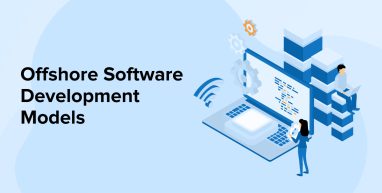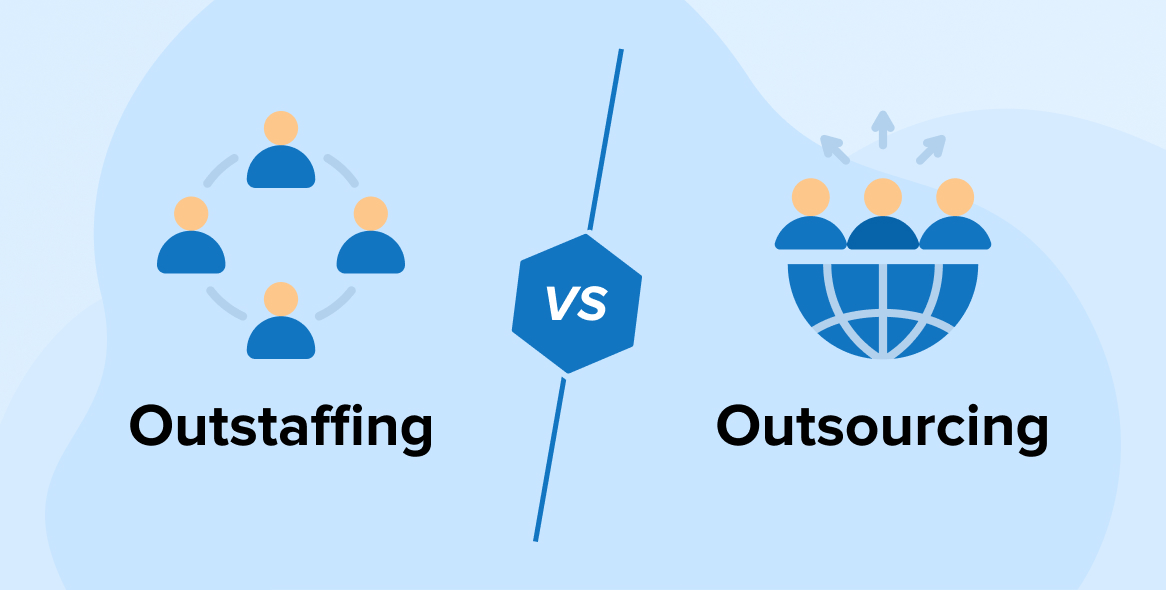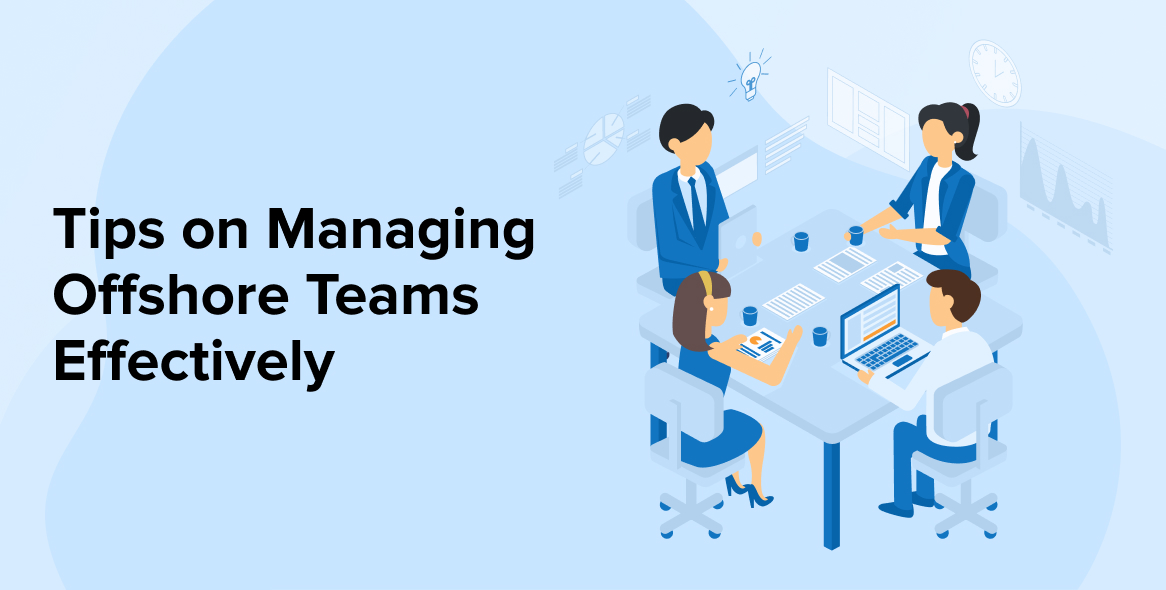
The software development industry is evolving to keep up with modern-day trends in this rapidly advancing technological world. With the emergence of futuristic technologies such as AR/VR, IoT, Artificial Intelligence, Blockchain, Quantum Computing, etc., the demand for skilled software developers at the relevant budget has increased by manifolds. Businesses often need help to get the required resources according to their project requirements and budget in their operating location. In such cases, an offshore software development company is a preferred choice to mitigate the imbalances in demand and supply in the IT domain.
In this blog post, we’ll learn about offshore software development models, including their various types and subtypes, and factors to consider before choosing an outsourcing model.
1. Overview of The Offshore Development Model
The offshore development model involves outsourcing software development tasks to a team or company located in a distant location, usually on a separate continent. This model outlines all the details, including development responsibilities, payment methods, task distribution, timelines, and partnership contracts. Companies typically choose offshore outsourcing to take advantage of global tech talent at an affordable rate and get high-tech software products. The labor costs are relatively cheap in offshore countries owing to their low living standards, resulting in cost savings for client companies.
The outsourcing model increases client companies’ operational efficiency by allowing tasks to be performed by their experts in their location. This shift enables businesses to focus on other critical aspects, such as increasing productivity and work efficiency. Due to these significant advantages, the offshore model is becoming a rapidly adopted versatile business model to fulfill diverse business needs cost-effectively, breaking geographical barriers.
2. Types of Offshore Development Models
There are multiple offshore development models in the market, and their categorizations also vary. To make things easy for you, we’re here with the nine most relevant offshore engagement models categorized based on three parameters:
- Levels
- Business Models
- Service Models
2.1 Offshore Software Development by Levels
This category of offshore development models classifies them according to the level of control a client company can have on the offshore software outsourcing company. This will determine the coordination between onshore and offshore teams and the resource accessibility limit.
The following are the three types of level-based offshore development models:
1. Low-Level Outsourcing
As the name suggests, this model promotes the lowest collaboration between the partner companies. Here, the vendor is responsible only for software development and quality assurance processes related to software delivery, while product management is still in the client’s hands. In the development process, offshore developers provide low-level coding solutions. The client side performs manual testing and test development.
This model effectively meets the client company’s budget constraints because it involves low-level assignments and minimal engagement. It is beneficial for even the offshore team as it provides them greater flexibility to work.
2. High-Level Outsourcing
In this model, product management remains in the client’s control. The offshore team designs test cases and performs tests under the surveillance of the client’s in-house team. The architect-level testers verify the built test cases. The offshore development center provides mid-level services such as solution design, project management, and test design. The architect-level software developers analyze the Product Requirements Document (PRD) on the client side.
3. Complete Technical Outsourcing
The offshore development center comprises the best technical specialists with expertise in advanced technologies such as AI, ML, IoT, etc. They have complete control of all technical aspects of software development. The client team just needs to create the Product Requirements Document(PRD). You can trust them to develop custom software solutions, whether for simple websites or applications or complex projects like developing healthcare portals containing multiple functionalities.
This model is preferred if you want reliable and advanced software and have an appropriate budget to hire experts.
2.2 Offshore Software Development by Business Models
Business models describe how an offshore development team serves the client company in return for their investment. The following are the three offshore outsourcing business models or billing models prevalent in the IT industry.
1. Fixed Cost Model
In this model, the term fixed cost means that the remuneration for the product to be delivered is decided before the offshore developers start software development. Before entering into the contract, the client and offshore team members discuss the project scope, necessary resources, budget, and completion timeline. Here, the decided cost remains the same throughout the product development regardless of changes in resource allocation or development time. There is no possibility of any concealed or unanticipated costs associated with the project.
The fixed-price model is ideal for projects with defined requirements, scope, and budget constraints. The pre-decided budget makes this model suitable for startups, and small to medium-scale industries, which often face financial constraints. They can rely on this model for predictable outcomes, consistency, high performance, on-time delivery, and minimum risks associated with the project. All these factors make this fixed-price model a great success.
2. Dedicated Development Team
The dedicated development team model, also called the Dedicated Resources Model, refers to assigning a particular development team for a specific client project. The client company has the flexibility to hire developers with the required skill set according to their project requirements. The designated team members work dedicatedly throughout the entire software development cycle. Even after the software deployment, some team members are there for permanent support and software maintenance. They work on the assigned project at a time.
The development team is cross-functional and recruited for long-term project development that demands high collaboration and communication between the partnering teams. The client team directly controls and supervises the tasks of the offshore team using various task management tools, maintaining control over project management. The offshore developers directly report to the client and work according to their instructions and feedback.
The dedicated development team model promotes long-term partnerships between onshore and offshore teams for ongoing projects. This model is beneficial from a security aspect because it is highly confidential and allows clients to maintain control over their Intellectual Property Rights (IPR).
3. Time And Material
If your project requirements can change in the future, the scope is unclear, the project volume is not fixed, the duration is unknown, or the workload cannot be estimated, you can opt for this model. This offshore software development model is based on the billing method. The offshore developers are paid according to the hours they spend working on the project and the cost of the resources incurred in the software development process. The project timeline and budget are decided in advance, and developers must complete the development and delivery within that deadline and budget.
The Time and Material model offers excellent flexibility and scalability for projects. Resources are efficiently managed because the client company can allocate and deallocate them according to project demand at a particular time. This is particularly beneficial for complex and sophisticated projects such as eCommerce applications, which are highly susceptible to additions or omissions to their software. Clients even wish to accommodate the ongoing market trends in their software to make it relevant. This model lets them do that effectively.
2.3 Offshore Development Model by Services
Outsourcing companies provide different services based on the client’s project requirements, complexity, size, etc. Client companies select the services they wish to take from their offshore development partners, establishing the criteria for the classification of the offshore service model. The chosen service model decides the work distribution between onshore and offshore development teams.
Let’s look at the three popular service-based offshore development models:
1. Project-Based
The project-based model is designed for pilot, unconventional, or unique software development projects with precise requirement specifications, deliverables, and timelines that are unlikely to change. These projects typically range from low to medium complexity. This project-based model fosters a healthy and long-term partnership, resulting in the engagement model like a dedicated development center.
The significant advantages of a project-based model are cost reduction, shorter time to market, no overhead costs, and the ability to obtain expert skill sets according to project needs.
2. Offshore Development Center
The offshore development center model is suitable for complex and long-term projects where clients aim for cost reduction without compromising on quality and resources. In this engagement model, the client selects an outsourcing company that forms a dedicated development team of top-notch developers that will work on a single project at a time. This team formed will be entirely under the client’s control. The offshore development centers are typically located in countries like India, which offer lower labor costs and appropriate infrastructure and support remote team needs to operate effectively.
These offshore development centers are advantageous in the long run for businesses looking to accomplish different challenging projects requiring sophisticated knowledge and technology. The outsourcing development costs depend on the technologies used and the number of developers associated with the software development process. This engagement model guarantees on-time deliveries complying with the quality standards and ultimately results in project success.
3. Staff Augmentation
To enhance your in-house team with technical experts, consider hiring the required number of offshore skilled developers for the desired duration. These remote software developers become an extended part of your development team. They will work under your supervision and get paid for the services offered for the entire agreement period. The augmented developers are assigned routine activities such as development, testing, prototype building, support, etc. However, they aren’t responsible for the project’s success or failure.
Staff augmentation is the most suitable engagement model for businesses in a hurry to hire specialized developers to meet an approaching deadline, fill skill gaps, or access global talents without going through the traditional hiring process and incurring administrative overheads. Here, the engagement is temporary, with technical leadership and project management in your hands. You will get the expected outcomes in the given time frames at lower costs, resulting in faster market time.
3. How to Choose The Right Offshore Development Model?

Now that you understand the various offshore development models, the next thing to do is to decide on the appropriate model for your software project.
It’s important to recognize that there is no best or worst offshore development model. The suitability of a model can vary significantly depending on the specific project. It is crucial to choose the model that fits your project goals and business needs criteria. There are many factors to take into consideration when deciding on the outsourcing model because this decision plays a substantial role in determining your project’s success.
Below are the four most important aspects you must think about when picking the right offshore development model.
3.1 Understand Your Project Requirements
This is the fundamental step before the actual offshore development process begins. Find out the answers to questions such as: Why do we need this particular software? What problems do we aim to solve through the software? What are our project requirements? Are these requirements fixed or are they likely to change in the future? Take appropriate time to answer these questions and list them.
3.2 Project Scope
Once you’ve got a rough idea of the project’s needs, it’s time to analyze the project scope. Start by considering your project goals. Are they short-term or long-term? For example, an eCommerce website wants to increase its online sales by 50%. Identify both the tangible and intangible project outcomes that you and the end users will achieve from the project. It’s essential to recognize all the stakeholders of your project and their roles and needs. Additionally, establish timeframes of the project deliverables, define success parameters, and anticipate possible challenges in the development process and their mitigation measures.
3.3 Your Budget Size
Many companies opt for offshore software development because of its cost-effectiveness. You can say that the cost is the major factor influencing this decision. There are various offshore development models, each with unique advantages and cost benefits. Businesses have to choose one that caters to their project objectives and fits within their budget. For example, a fixed-price model is an ideal option for companies with limited financial resources.
Sit with your entire project management team and analyze the offshore development models present in the market. Make a well-planned project budget and match your project specifications with the characteristics of the engagement models.
3.4 Team Size
Different engagement models are associated with respective team strengths. For instance, the team size in the complete technical outsourcing model is large because they are involved in building high-level, challenging projects. According to your project requirements, figure out the number of offshore developers you need for your development team.
4. Final Words
Choosing the right offshore development model may prove highly advantageous for your business. While the decision-making process can be complex, it is ultimately beneficial. Begin with a proper study of the market conditions in both your country and the potential offshore locations. After that, you will be able to find the correct offshore software development partner. It’s important to examine the different engagement models, along with their benefits and limitations, and suitable project types to make your decision. It feels difficult when you try anything for the first time, but you’ll get through with a proper selection approach.






Comments
Leave a message...